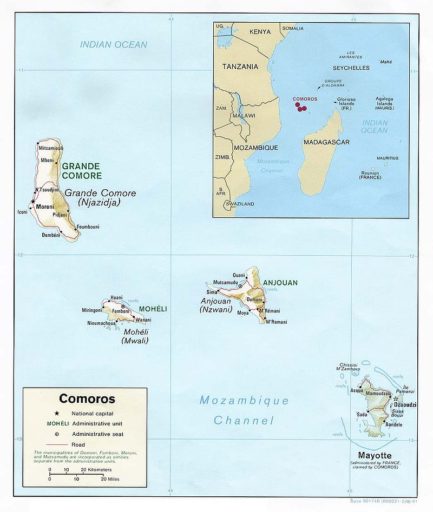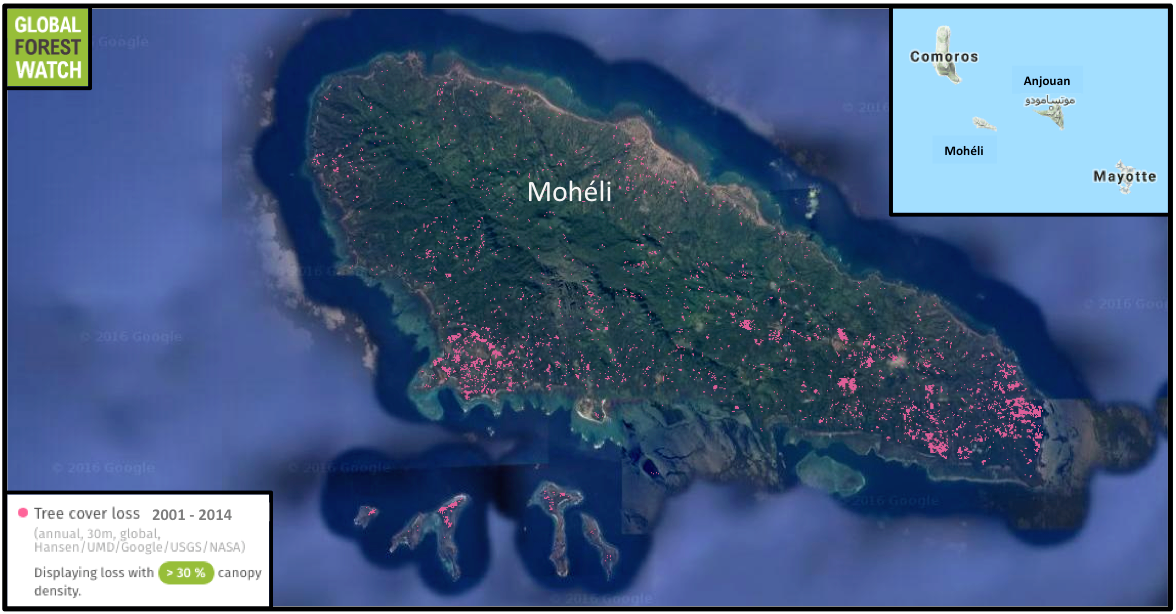The rare bat is found only on two small islands of Anjouan and Mohéli in the Comoros archipelago, off the southeast coast of Africa.Around 19 of the 21 remaining bat roost sites have been affected either by tree cutting, agricultural encroachment or soil erosion.This bat may possibly have the lowest population estimate among all fruit bats, researchers suggest.
Widespread deforestation is causing severe population decline in the little-known Livingstone’s fruit bat (Pteropus livingstonii), a new study has found.
The rare bat is found only on two small islands of Anjouan and Mohéli in the Comoros archipelago, off the southeast coast of Africa, where its population is down to about 1,200 individuals, researchers report in the study published in Oryx. These few individuals are distributed across 21 roost sites on the islands, most of which are threatened by habitat loss. The species is currently listed as Critically Endangered on the IUCN Red List.
The findings were alarming, co-author Richard P. Young, Head of Conservation Science at Durrell Wildlife Conservation Trust, U.K., told Mongabay.
“All but two of the 21 long-term sites the bat habitually used for daytime roosts have been affected either by tree cutting, agricultural encroachment or soil erosion caused by upslope deforestation,” Young said. “This represents an alarming upturn in the threats to this species.”
Livingstone’s Fruit Bats in the wild. Photo credit: Bronwen Daniel.
The Livingstone’s fruit bat, also called the Comoro flying fox, needs native and endemic trees in relatively undisturbed old-growth forests to survive. However, forests on the Comoro Islands have suffered one of the highest rates of deforestation in the world, researchers say. This rampant deforestation, fueled by cutting of old-growth trees for construction wood, agricultural expansion and poor farming techniques, has reduced old-growth forests on the islands to patches of about 60 square kilometers that are now restricted on higher elevations and steep slopes. Consequently, suitable habitat for the bats is disappearing rapidly.
 The Livingstone’s fruit bat is found only on two small islands of Anjouan and Mohéli in the Comoros archipelago.
The Livingstone’s fruit bat is found only on two small islands of Anjouan and Mohéli in the Comoros archipelago.
Recent surveys, conducted by Young and his colleagues at the Durrell Wildlife Conservation Trust, Bristol Zoological Society and local NGO Dahari, found that only about 1,260 individuals of the species survive in these forests today. In fact, the Livingstone’s fruit bat may possibly have the lowest population estimate among all fruit bats, the researchers suggest. The Critically Endangered Rodrigues fruit bat (Pteropus rodricensis) may have the next lowest known population size of about 10,000 individuals, the authors write in the paper.
“The remaining roost sites occur in a narrow altitudinal band between the upper reaches of the agricultural zone at 600-800 meters and around 1,000 meters in elevation, above which the bats don’t seem to roost despite there being remaining forest,” Young said. “We also found a negative relationship between the numbers of bats at a particular roost site and the degree to which the surrounding forest was disturbed, suggesting the bat doesn’t fare well when the forest canopy is opened and large trees are cleared. So, unfortunately, there appears to be few places for the bats to go.”
 Data from the University of Maryland and visualized on the forest monitoring platform Global Forest Watch show the island of Mohéli lost more than 4 percent of its tree cover between 2001 and 2014. Neighboring Anjouan, the only other place inhabited by the bats, lost nearly 2 percent during the same time period.
Data from the University of Maryland and visualized on the forest monitoring platform Global Forest Watch show the island of Mohéli lost more than 4 percent of its tree cover between 2001 and 2014. Neighboring Anjouan, the only other place inhabited by the bats, lost nearly 2 percent during the same time period.
However, hope remains for the imperiled species.
To secure the bats’ long-term roosts, Dahari has developed a pilot Payments for Ecosystem Services-based scheme that incentivizes farmers to protect and restore forests around the roosting sites. This scheme has been successfully implemented in the first roost site in the village of Adda.
“Abdourahamane, the farmer who owns the field containing the Adda roost site, has signed a contract agreeing to preserve the roost trees in perpetuity and to regenerate native forest in his field,” Hugh Doulton, Technical Advisor at Dahari, told Mongabay. “In return, Dahari is supporting agricultural development in his fields located elsewhere in the landscape, and is providing a payment each time tourists or researchers visit the roost site. This payment will be supplemented or replaced with revenues from selling timber once there are enough big trees in the area to allow for sustainable offtake, with tree-cutting to be agreed between Abdourahamane, Dahari, and the local mayor’s office.”
 Abdourahamane signing the first agreement to preserve the Livingstone roost site at the mayor’s office in Adda in the presence of village leaders and the village forest management committee. Photo credit: Dahari.
Abdourahamane signing the first agreement to preserve the Livingstone roost site at the mayor’s office in Adda in the presence of village leaders and the village forest management committee. Photo credit: Dahari.
Dahari also plans to help Abdourahamane lead the expansion of the forest and agroforestry protection area with neighboring farmers. “We are looking at generating community benefits to ensure wider buy-in to the conservation scheme,” Doulton added.
The Livingstone’s fruit bat remains largely understudied. And this poses a challenge to provide specific conservation recommendations, Young said. Conducting more field research, securing remaining old-growth and degraded forests, as well as supporting local initiatives that involve farming communities in conservation measures is essential to saving the species, he added.
“Ultimately, it’s vital to keep battling to save this species, both of course for its own sake but, given its role in seed dispersal and pollination, also for the health of the remaining fragments of mountain rainforests and the future wellbeing of rural communities,” Young said.
 Livingstone’s Fruit Bats at Durrell Wildlife Conservation Trust. Photo Credit: Tiffany Lang.
Livingstone’s Fruit Bats at Durrell Wildlife Conservation Trust. Photo Credit: Tiffany Lang.
Citation:
Daniel, B.M., Green, K.E., Doulton, H., Mohamed Salim, D., Said, I., Hudson, M., Dawson, J.S. and Young, R.P. (2016) ‘A bat on the brink? A range-wide survey of the Critically Endangered Livingstone’s fruit bat Pteropus livingstonii’, Oryx, , pp. 1–10. doi: 10.1017/S0030605316000521.
FEEDBACK: Use this form to send a message to the author of this post. If you want to post a public comment, you can do that at the bottom of the page.
Animals, Bats, Biodiversity, Conservation, Critically Endangered Species, Deforestation, Environment, Forests, Habitat, Habitat Degradation, Habitat Destruction, Habitat Loss, Mammals, Payments For Ecosystem Services
Africa, Comoros
Source link : https://news.mongabay.com/2017/01/worlds-most-endangered-bat-could-soon-be-extinct-due-to-rapid-forest-loss/
Author :
Publish date : 2017-01-10 08:00:00
Copyright for syndicated content belongs to the linked Source.





